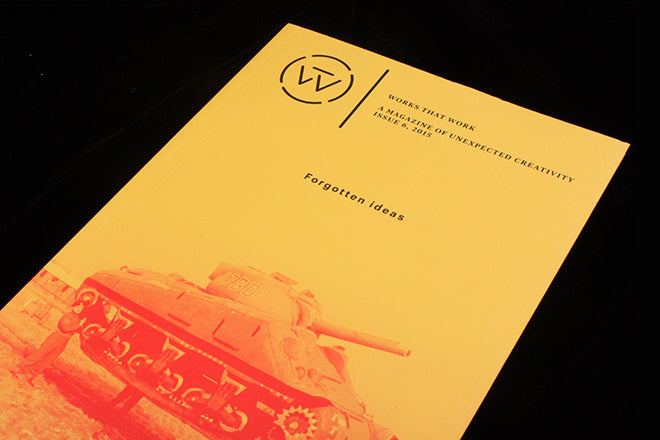
Works That Work #6
There’s a trend for magazines that approach the topic of creativity from unusual angles – Dirty Furniture and Makeshift are two fantastic examples of publications that reject a surface driven approach to design journalism. Works That Work from studio Typotheque is another singular magazine when it comes to unexpected stories about creativity and design, and issue 6 might be its most intriguing to date.
The new theme is ‘Forgotten ideas’, and by telling stories about concepts that never succeeded in becoming a reality, Works That Work hints to a kind of Utopia that could have been. The magazine’s stories can’t be found via a simple Google search, and the editor Peter Bil’ak writes in his letter that they look for ‘relevance, not recentness’ when hunting for potential articles.

 Some of the ideas they document in the new issue are hilarious – like a photography project from the 1940s that dressed mothers in dark clothes to camouflage them against the backdrop for portraits of restless toddlers (above). Other design stories are steeped in strange and unfamiliar history, like a photography series that documents bus stops from the former USSR (also above). One of the most exciting – and relevant – stories is about veteran and Broadway actor Garry Davis’s 1948 self-issued World Passport (below). Davis believed that the only way for everlasting peace was the establishment of a unified global government, and he designed the document after declaring himself a ‘citizen of the world’.
Some of the ideas they document in the new issue are hilarious – like a photography project from the 1940s that dressed mothers in dark clothes to camouflage them against the backdrop for portraits of restless toddlers (above). Other design stories are steeped in strange and unfamiliar history, like a photography series that documents bus stops from the former USSR (also above). One of the most exciting – and relevant – stories is about veteran and Broadway actor Garry Davis’s 1948 self-issued World Passport (below). Davis believed that the only way for everlasting peace was the establishment of a unified global government, and he designed the document after declaring himself a ‘citizen of the world’.

 On powder green paper (different papers are a feature of the mag), a fantastic essay explores Nasri Khattar’s attempt to unite all of the variations of the Arabic letters into a simple typeface to combat illiteracy (above). A story on The Munsell Colour System looks at another entrepreneurial design invention - a project that set out to create a standardised glossary of colours in the form of a three-dimensional tree (below).
On powder green paper (different papers are a feature of the mag), a fantastic essay explores Nasri Khattar’s attempt to unite all of the variations of the Arabic letters into a simple typeface to combat illiteracy (above). A story on The Munsell Colour System looks at another entrepreneurial design invention - a project that set out to create a standardised glossary of colours in the form of a three-dimensional tree (below).
 Works That Work always push the boundaries of what should be considered design; they leap away from the studio visit format and find surprising ways that creativity impacts the world around us. In this way, their magazine feels more like a publication of vigorous investigative journalism than traditional art and design writing.
Works That Work always push the boundaries of what should be considered design; they leap away from the studio visit format and find surprising ways that creativity impacts the world around us. In this way, their magazine feels more like a publication of vigorous investigative journalism than traditional art and design writing.


